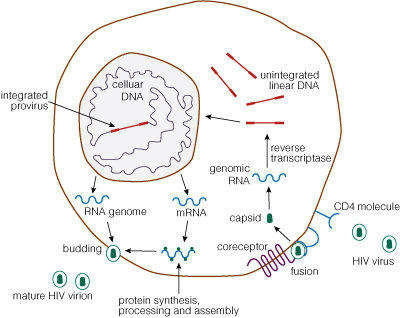
Scientists investigating the human immunodeficiency virus (HIV) have learned much about the retrovirus’s lifecycle, but their ultimate goals were to discover a cure and prevent infection. In the decades since HIV was discovered, basic research and pharmaceutical drug development have expanded the antiviral toolbox, but these HIV treatments do not provide a functional cure, only manage the infection. However, two techniques may offer a potential cure for HIV infection using CRISPR and a possible vaccine using mRNA.
CRISPR-Based Therapy May Cure HIV Infection
The FDA recently granted start-up company Excision BioTherapeutics authorization to begin Phase I/II human trials to test a one-time CRISPR-based gene therapy in HIV-infected individuals. Essentially, this method will act as a genomic surveillance system, finding where the HIV proviral DNA is hiding in the human genome, targeting three sites in the HIV genome and removing the latent viral sequence. Removing the viral sequences present in human cells means that no more viral particles will be produced, thus breaking the chain of viral reproduction and infection.
Permanently deleting the proviral DNA that lurks in the human genome has been a long-standing challenge for researchers. No cure can be complete without removing the sequence source that produces more HIV particles. CRISPR gene editing offers a precise targeting method to remove the unwanted DNA code while leaving the human genome intact.
mRNA Vaccine May Prevent HIV Infection
The company Moderna became front-page news after developing a mRNA vaccine against SARS-CoV-2, one that was effective at preventing COVID-19. Using the same mRNA technology, Moderna has developed an experimental vaccine against HIV that will be in clinical trials this year. This is the first mRNA-based HIV vaccine to be tested in humans.
HIV researchers have known that broadly neutralizing antibodies are the key to stopping HIV. However, determining where HIV was most vulnerable and designing immunogens that the immune system would recognize and develop antibodies against the virus presented a big challenge. By collaborating with the International AIDS Vaccine Initiative (IAVI) and the Bill and Melinda Gates Foundation, Moderna is using its mRNA platform along with an engineered immunogen developed by IAVI and partners to stimulate B cells and generate an immune response against HIV. This clinical trial is the first step in learning if the potential vaccine is safe and able to generate antibodies against HIV.
Learn more:
Excision BioTherapeutics technology
FDA approves first trial investigating CRISPR gene editing as HIV cure
Moderna set to start human trials of experimental mRNA HIV vaccine
Do you study infectious diseases? We have tools and resources to assist you in your research and discovery.
Sara Klink
Latest posts by Sara Klink (see all)
- A One-Two Punch to Knock Out HIV - September 28, 2021
- Toxicity Studies in Organoid Models: Developing an Alternative to Animal Testing - June 10, 2021
- Herd Immunity: What the Flock Are You Talking About? - May 10, 2021
